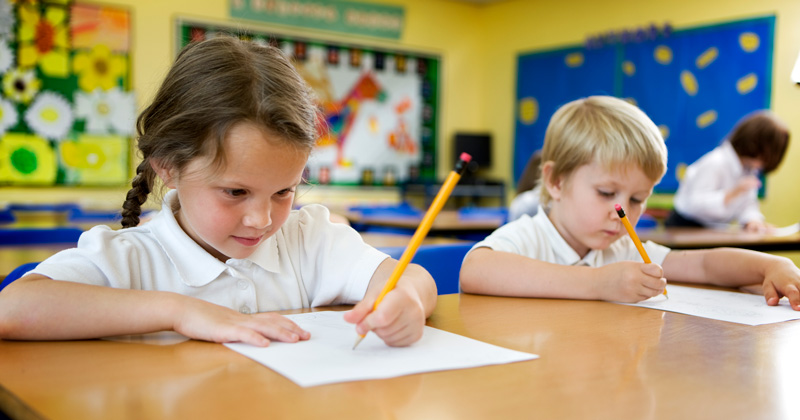Primary school exams in the UK, called SATs, are tests that children take at the end of Key Stage 1 (Year 2) and Key Stage 2 (Year 6). They help teachers understand how well students are learning and progressing. SATs also give parents an idea of how their child is doing in school.
The results of these exams are important because they show the government and schools how effective teaching is. You can find your child’s school results on government websites or platforms like The School Guide.
Further, the exams are set and marked by a group called the Standards & Testing Agency. Overall, SATs help everyone understand how well children are doing in school and how schools can improve.
Key Exams in Primary School

Key Exams in Primary Schools in the UK are crucial assessments that gauge student progress and achievement at specific stages of their education. The two main key exams are the Key Stage 1 (KS1) and Key Stage 2 (KS2) assessments.
Key Stage 1 (KS1) Assessments
KS1 assessments are typically taken by students at the end of Year 2, around the age of 7. They aim to evaluate basic skills in
- English (reading and writing)
- Mathematics.
These assessments help teachers and schools identify areas where students may need additional support or intervention. The KS1 assessments primarily focus on English and Mathematics, although some schools may also include Science assessments.
These assessments are administered internally by schools and are not standardized national exams. They usually occur in the classroom environment over a while, with teachers assessing student performance through various tasks, tests, and observations.
Key Stage 2 (KS2) Assessments
KS2 assessments are taken by students at the end of Year 6, typically around the age of 11. They are more formalized than KS1 assessments and are designed to assess a broader range of skills and knowledge across multiple subjects, including
- English Reading
- English Grammar
- Punctuation
- Spelling
- Maths
KS2 assessments are standardized national exams administered by external examination boards. They usually take place over several days in May of Year 6. The assessments include a combination of written tests and tasks, with strict guidelines for administration and marking.
What Is The Scaling System For Ks2 And Ks1?

The scaling system for Key Stage 1 (KS1) and Key Stage 2 (KS2) SATs involves converting raw scores into scaled scores, which are then used to assess a child’s performance relative to the expected standard and for comparisons across schools and cohorts.
Key Stage 1 (KS1)
Raw scores are converted into scaled scores, with 85 being the lowest and 115 being the highest possible score.
Score breakdown:
- 115: Highest achievable score.
- 101-114: Exceeded the expected standard.
- 100: Expected standard.
- 85-99: Not met the expected standard.
No direct consequences for children not meeting the expected standard; KS1 SATs primarily serve as indicators of progress for the school and a child’s early educational journey.
Key Stage 2 (KS2)
Raw scores are converted into scaled scores, with 80 being the lowest and 120 being the highest possible score.
Score breakdown:
- 120: Highest achievable score.
- 101-119: Exceeded the expected standard.
- 100: Expected standard.
- 80-99: Not met the expected standard.
Similar to KS1, there are no direct consequences for children not meeting the expected standard. KS2 SATs mainly act as indicators for appropriate academic placement and preparation for secondary school.
Secondary schools may use KS2 SATs data for initial assessments but often supplement it with their own evaluations.
What Are The SATs Tests Like?

When it comes to SATs, you might picture a big exam hall, but that’s not how it usually goes. In 2024, Year 2 and Year 6 SATs are often taken right in your child’s classroom. But remember, each school might do things a bit differently, so it’s good to ask the teacher if you want more details.
As for the tests themselves, they’re meant to check what your child knows and how well they can use what they’ve learned. The questions are kind of like what they’ve seen in class or on tests before. They cover stuff they’ve learned throughout primary school, not just in Year 6. So it’s a chance for them to show what they’ve picked up along the way.
Sats Jargon Explained
Here’s a breakdown of SATs jargon to provide clarity on commonly used terms
SPaG
Refers to spelling, punctuation, and grammar tests within the English SATs.
National Standard
The level children are expected to achieve in their SATs, set at 100 for both Key Stage 1 (KS1) and Key Stage 2 (KS2).
National Curriculum Tests
The official name for SATs, although commonly referred to simply as SATs.
Floor Standard
The minimum standard expected by the government for schools to meet. If under 65% of pupils meet the expected standard in reading, writing, and maths, and fail to make sufficient progress, the school is considered below the floor standard.
Expected Level/Standard
A score of 100 indicates a child is working at the expected standard.
Raw Score:
The number of marks a child obtains on the SATs tests.
Scaled Score
A converted score enables comparison of SAT results across different years, accounting for variations in test difficulty and other factors.
Age-standardized Test Scores
Conversion of a pupil’s raw score to a standardized age score, facilitating comparison with peers born in the same month nationally.
League Tables
Tables produced by the Department of Education rank primary schools based on various measures, including SATs results.
How To Prepare For SAT’s?

Preparing for SATs involves a combination of understanding the content, practicing exam-style questions, and providing support to ensure your child feels confident and reassured. Here’s a guide on how to prepare effectively:
Understand the Content
You need to familiarize yourself with the topics covered in both Maths and English SATs. In Maths, focus on addition, multiplication, subtraction, and division, as these are fundamental operations.
For English, be aware that reading, writing, spelling, and grammar are assessed. Understand the level of complexity expected for each Key Stage (KS1 and KS2).
Practice and Revise
Regularly you need to practice Maths operations such as addition, multiplication, subtraction, and division with your child. Utilize resources such as worksheets, online exercises, or educational apps to reinforce their understanding.
For English, encourage reading comprehension by exploring a variety of texts, discussing them, and practicing writing skills. For KS2, emphasize analysis, synthesis, and inference from different sources.
Ensure Confidence and Reassurance
SATs can be a stressful time for children, so it’s crucial to provide reassurance and support. You must encourage a positive mindset and remind your child of their capabilities. Be available to answer questions and provide assistance when needed. Explore resources on mental health and wellbeing to implement strategies that promote relaxation and confidence.
Practice SATs Papers
Access practice SATs papers and questions provided by official sources such as the Standards and Testing Agency and the Department for Education websites. These resources offer exam-style questions that familiarize your child with the format and structure of the SATs.
Additionally, seek out practice papers tailored specifically for KS1 and KS2 to ensure comprehensive preparation.
Track Progress and Adjust
Monitor your child’s progress throughout the preparation process. Identify areas of strength and areas that need improvement. Further, adjust your study plan accordingly, focusing more on challenging topics and providing additional support where necessary.
How Are Ks2 Sats Marked?
KS2 SATs are a more formal testing process with set exam days and external markings in most schools. Additionally, some schools choose to conduct teacher assessments for speaking and listening, writing, and in some cases, science.
Further, These assessments provide a broader view of a child’s performance in a subject over a longer period. They allow teachers to consider the child’s overall knowledge and ability beyond what’s demonstrated in a test environment.
How Are Ks1 And Ks2 Sats Scored?
Since 2016, the scoring of KS1 and KS2 SATs has shifted from using National Curriculum levels to scaled SATs scores. This scaling system is employed globally for school assessments. It is considered fair because it adjusts for differences in test difficulty from year to year.
It allows for comparisons across different cohorts, ensuring a consistent and equitable evaluation of student performance.
How Do Sats Exams Impact Education?
The impact of SATs exams in primary schools touches many parts of the education system. They help track how well students are doing and spot areas where they need help. Schools with good results might get extra help, while those with lower scores might need support.
It also affects what gets taught in school and how teachers teach it. But they can also make students feel stressed. Schools try to help students cope and make sure they’re okay. Teachers work hard to get students ready for SATs, which can be tough sometimes. SATs results are shared with parents, so they can support their child’s learning.
Overall, SATs exams affect students, teachers, schools, and even the rules made by the government about education.
What Are Some Challenges Of Sats Exams?
SATs exams in primary schools face various challenges and criticisms. One big problem is how much pressure they put on students, especially in Year 6.
Some people worry this stress makes the curriculum too narrow, focusing too much on what’s tested instead of giving kids a broader education. Others say these tests might not show what students are really capable of. Teachers also feel the pressure to get good scores, which can be tough.
Plus, not all students do equally well, which isn’t fair. To make it better, everyone like teachers, parents, and students needs to talk and work together. This way, you can make sure SATs help students learn and grow while making sure everyone gets a fair shot.
FAQ’s
What are the tests for primary school in England?
SATs, or national curriculum assessments, are assessments of primary pupils’ progress and attainment. They are currently completed at the end of key stage one (infant phase) and key stage two (end of primary/junior phase).
What are the SATs in UK schools?
SATs are standardised assessment tests administered by primary schools in England to children in Year 2 and Year 6 to check their educational progress. They are one marker used by the government, and hence parents, of the quality of the education at a school.
What are the competitive exams for kids in the UK?
The 7+ and 11+ systems refer to the two different models of entrance exams used by selective schools in the UK. The 7+ exam is typically taken in Year 2, when children are 6-7 years old, while the 11+ exam is taken in Year 6, when children are 10-11 years old.
Final Words
SATs in UK primary schools are crucial tests that tell teachers, parents, and the government how well children are doing in their learning journey. By checking results online, parents can see how their child is progressing. SATs are set and marked by a group called the Standards & Testing Agency.
Further, they help schools figure out what they’re doing well and where they can improve. So, these exams are really important for making sure kids get the best education possible.
